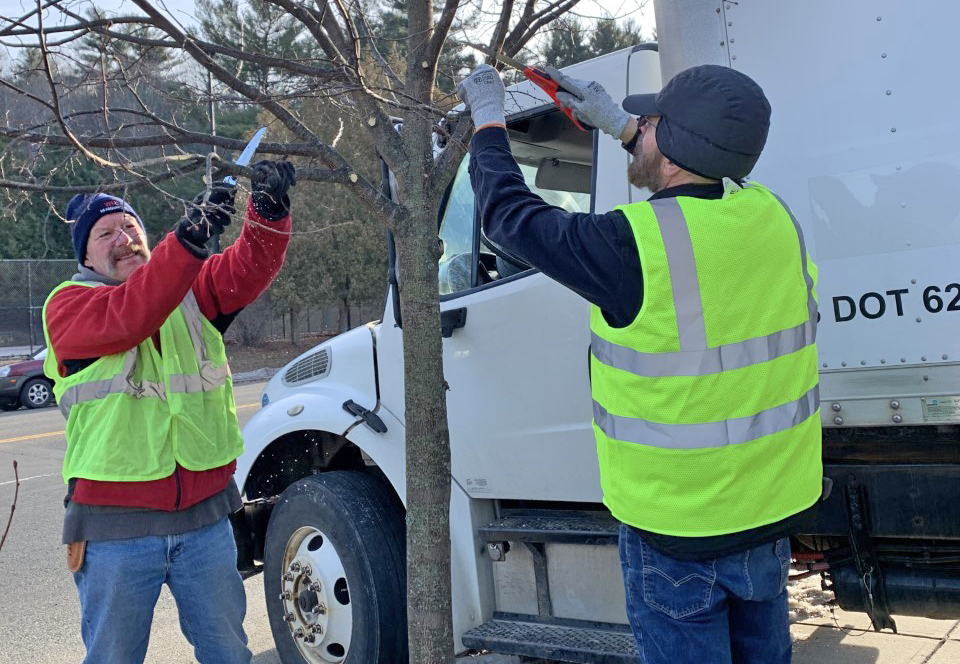
By Ruth Seward Director, Outreach & Community Engagement
As the weather becomes colder and the excitement of Night Lights consumes visitors, staff and volunteers at New England Botanic Garden at Tower Hill, a smaller group of volunteers and staff plods carefully along in the community, methodically pruning city of Worcester street trees. By comparison the work seems unceremonious and can be easily overlooked. However, it is an important task that the garden staff of the outreach department is doing in partnership with the city of Worcester. This patient, consistent volunteer program demonstrates New England Botanic Garden at Tower Hill’s commitment to good horticulture, even in the urban environment.
For street trees, structural pruning can be critical for long term health and survivability. This type of pruning focuses on the defects of the structure of a tree, such as crossing branches or double leader growth, and remedying it through proper pruning cuts. If left unchecked, problems like crossing branches can grow together with a weak attachment. This will make them more susceptible to breaking as they become older, larger and much heavier. Some troubles we see in the field include arbor tie left on a tree too long now growing into the bark, which injures the tree. We see pruning cuts on trees that do not follow best practices guidelines which lead to larger problems for the trees. We see scars at the base of trees from weed whackers or vehicle collisions which harm and even kill trees.
City trees need to be ‘limbed up’ which is having their lower branches taken off to keep them from being ripped off by cars or to prevent them from interfering with pedestrian traffic on sidewalks. Usually, a public street tree has its lowest branch above eye level, or five feet. However, even limbed up trees get broken when trucks swipe them on residential roads. Trees heal less quickly from jagged broken branches than they do from clean pruning cuts. Faster healing means less opportunity for pathogens or disease to enter the tree. Therefore, part of the goals of structurally pruning street trees is to prevent potential problems for the tree by eliminating branches in the path of human interference.
It is important to structurally prune a tree while it is in its youth, after the tree has become established. A young tree can recover from pruning cuts more readily than an older tree can. Smaller branches are much easier to cut and catching tree growth problems such as crossing branches, before they are a danger to targets on the ground. Tree problems which might rectify themselves in natural settings become dangerous in built settings. In the woods, having tree limbs fall because they have died is natural but in the city such events are dangerous and can be costly. There are so many stress factors on trees in a city that do not exist in a natural setting that it is important to reduce as many stress factors as possible to keep the trees healthy.
As we prune, we move tree to tree and observing their vigor, their structure and their surrounding conditions. Recording these observations help to paint an important picture of how the urban tree canopy is developing. Every time we prune street trees, we record their health and enter this information into a large spreadsheet. Information collected in the field will be used to generate tree benefits reports using the US forest Service Program, I-Tree. This application generates useful reports regarding oxygen production, carbon sequestration, storm water interception and other useful urban planning projects.
New England Botanic Garden at Tower Hill’s Outreach Department trains and organizes its Tree Stewards throughout the fall, winter and early spring. The work done in Worcester benefits the trees; supplements the work done by the city Forestry department and improves community tree canopy for everyone to enjoy. Additionally, it allows us to interact with residents of the community, since people come out to talk when they see us pruning the trees. The street tree pruning program is one important way that New England Botanic Garden at Tower Hill Botanic Garden connects people with plants in the urban setting.
